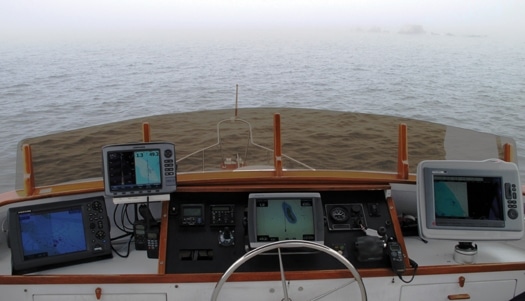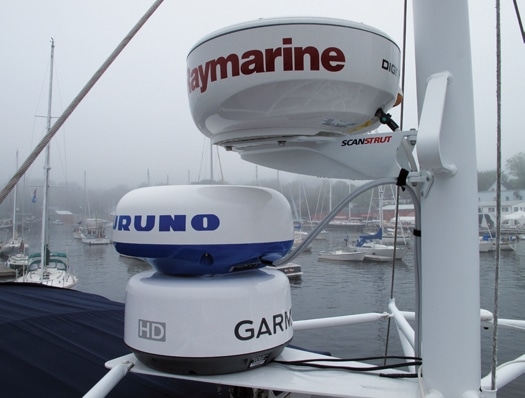
ytgoct23elect525.jpg
We’ll call it a voyage of radar discovery. As summer went on, Gizmo’s 18-inch radomes multiplied: A Garmin GMR 18 HD and a Furuno DRS2D joined the Raymarine RD418D and Navico BR24 (used with both Simrad and Lowrance systems) discussed last month, and that column’s central theme was confirmed. Radar engineers are getting more performance from small radar scanners than I thought possible-though the techniques involved lay mysteriously beyond normal specifications-and can even make traditional magnetron technology nearly replicate the amazing close-range resolution that’s a prime feature of Navico’s innovative solid-state Broadband Radar.
In fact, the Furuno outperformed the Raymarine, and came hair-close to the Navico, at sorting out the target mess in Camden’s outer harbor. It’s understandably the only one of the three tested maggies to offer a 400-foot range (also expressed as .0625 or 1/16 nm, depending on manufacturer). This is especially counterintuitive as the DRS2D has the shortest scanner of the lot and hence has a slightly wider horizontal beamwidth, which should result in cruder resolution.
And there was more specifications confusion: The Furuno DRS2D, though actually the lightest dome with the least volume, is also called the Ultra HD 19-inch. But Furuno’s 19 inches refer to the dome-casing diameter, whereas Raymarine’s “18-inch” radome is actually 20.5 inches wide with a true 18-inch antenna spinning inside!
Meanwhile, the Garmin 18 (case diameter in inches) tended to blow out smaller targets at close range- though it did better with its gain manually turned down-and it remembers custom gain settings nicely for each range. But it did make good use of its 4 kW transmit power to bring in bold headlands up to 20 miles away, much as the 4 kW Raymarine dome did, both without manual adjustments. The Furuno, pulsing at only 2.2 kW, doesn’t have the same reach, though the range difference is certainly not proportional to the power difference, and one guest tester said that the little DRS2D was painting distant shorelines as well as the older Furuno 4 kW 4-foot open array he’s used up and down the Atlantic for years. At best, specs on which we have long relied to differentiate the expected performance of radar only hint at what’s happened to radar technology.
Of course, in traditional terms, the ability of band’s miniscule 0.01-watt peak power to reach even eight or 10 miles is incomprehensible, as are the instant-on and zerosafe- distance characteristics explained last month. But while lowering the BR24 to a front-of-flybridge mount did slightly improve its extreme close-range performance, I was surprised that it could not see backwards at any range through Gizmo’s cored-fiberglass bridge structure and related gear. So while BR generally offers the most mounting flexibility, it’s also particularly sensitive to onboard obstructions; location experimentation is advised before drilling holes.
Relatively modest performance differences aside, any one of these modern radars is useful in thick fog or dark of night. But going out with all four, along with five different displays (both Simrad and Lowrance for the Navico BR24), was a serious education in the many ways radar imagery can be enhanced. I was pleased to find that all five MFDs could overlay radar on their charts well, and had to grin remembering how this now popular and nearly universal feature was pooh-poohed when it first came out. I’m hearing similar derision about overlaying radar on 3-D charts-“Who needs that?!?”-but I’m learning to like it too. While 2-D overlay makes it easier to separate known targets from unknowns, 3-D lets you see more detail near your vessel while maintaining a longish look ahead.
The ultimate way to see near and far, though, is the fully independent dual-range feature currently available only from the Furuno. Furuno’s NavNet 3D, along with the Garmin’s 4000 and 5000 series, are also the only MFDs that can currently do 3-D radar overlay. And Furuno builds the only recreational radar with ARPA, or Automatic Radar Plotting Aid. Furuno engineers have stayed ahead of the pack, and the company manufactures some radar subsystems that others get off the shelf, but let’s note that the DRS2D radome retails for $2,600, considerably more than the others, particularly the $1,199 Garmin 18 HD.
While it was remarkable that Gizmo had ARPA like the big ships that occasionally transit Penobscot Bay, its ability to track every moving object automatically in a preset guard zone was somewhat messy given a plethora of coastal targets. But I sure liked MARPA, which supposedly stands for Mini ARPA but is better understood as “Manual ARPA.” Move the cursor to a possibly dangerous target, like one of those ships, hit the OK button, and the MFD will figure out its course and speed, and display it much like the AIS targets that can also show on these radar screens or overlays (and which often explain a target without the need for ARPA). The Furuno, Raymarine, and Garmin systems all did MARPA quite well, with targets especially easy to select on the Garmin touchscreen 5212.
I should also note that these radar overlay and plotting features don’t work unless the display has accurate heading data as well as GPS. But supplying such info has gotten easier with modern systems, and, in fact, I could simultaneously feed all five MFDs with the same heading and GPS sensors, or redundant backups, using a NMEA 2000 network. This setup also let me try another big-boat feature called True Motion, available on the Furuno and Raymarine systems. Most of us are used to looking at radar, and electronic charts, in relative motion-that is, with our boat fixed on the screen and everything else moving relative to our course and speed, or, in the case of other moving vessels, a combination of our motion and theirs.
If you use the universal and potentially valuable radar feature usually called “echo trails” when in relative motion, a buoy will soon develop a trail as it moves across your screen, an island can leave a large blotch, and watch out if you turn. But in true motion, it’s your vessel that moves across the screen and only moving radar targets develop trails, which indicate the target’s actual course. Similarly, AIS and MARPA target graphics work better in true motion. Frankly, though, I’m not sure I can get used to having my own true motion boat jump back across the screen from time to time.
Then again, I’ve only had limited true motion time underway so far, and may change my motion emotion as the great Gizmo 2009 radar test goes forward. What started as a simple test of Broadband Radar got rather complicated, as I realized that several other modern radomes were also producing extraordinary results. Now Raymarine wants me to try its new 18-inch HD radome, which may be near Furuno level, and Garmin wants me to try its 24-inch HD radome, which purportedly performs significantly better than its 18.

| | |
And with all these displays on Gizmo, I can’t help but look beyond radar performance and features to the bigger picture a typical boater faces. Each MFD series has a distinctive set of charting, sonar, weather, video, interface, and radar features, which add up to a sum that is much greater than any one part. So I’ll keep testing until the weather really turns, and reporting results at my blog (see www.panbo.com). The big picture system choice is a tough one, but from what I know so far, there’s no really poor choice, and the new MFD series look even better.









